Analyzing Negligence, Duty of Care, and Contract Law Principles
VerifiedAdded on 2023/05/28
|10
|3885
|439
Case Study
AI Summary
This case study delves into two primary areas of business law: negligence and contract law. The negligence analysis focuses on the tort of negligence, highlighting its key elements such as duty of care, breach, causation, and remoteness of damages, with a particular emphasis on the neighbor principle established in Donoghue v Stevenson. The analysis explores the role of foresight in determining liability, referencing cases like Topp v London Country Bus, Home Office v Dorset Yacht Co Ltd, and Bourhill v Young to illustrate the application of the neighbor test. The contract law section examines the requirements for a valid contract, including offer, acceptance, and the distinction between offers and invitations to treat, referencing cases such as Partridge v Crittenden, Felthouse v Bindley, and Scammell & Nephew v. Ouston to clarify these concepts.

0
Business Law
Business Law
Paraphrase This Document
Need a fresh take? Get an instant paraphrase of this document with our AI Paraphraser
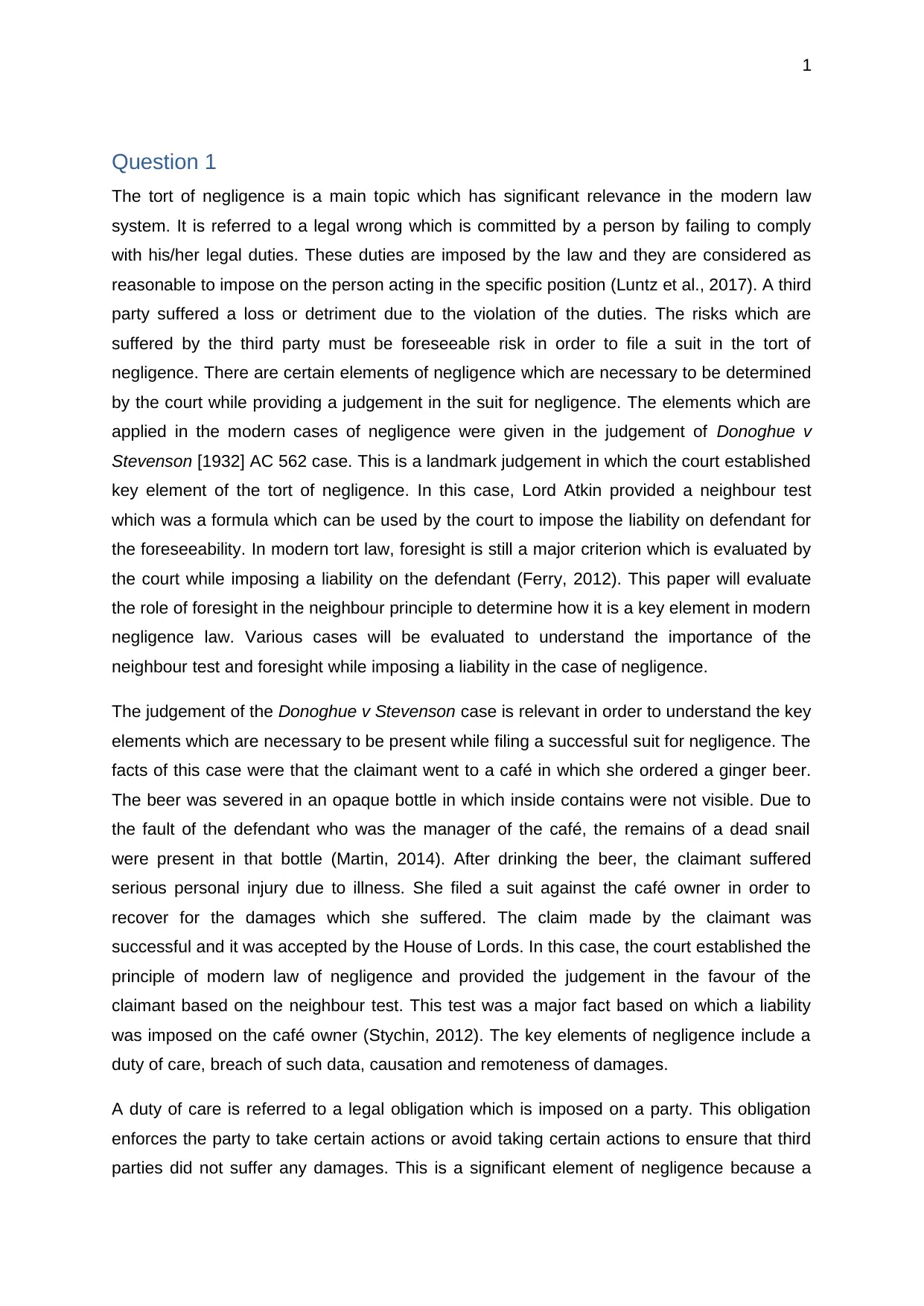
1
Question 1
The tort of negligence is a main topic which has significant relevance in the modern law
system. It is referred to a legal wrong which is committed by a person by failing to comply
with his/her legal duties. These duties are imposed by the law and they are considered as
reasonable to impose on the person acting in the specific position (Luntz et al., 2017). A third
party suffered a loss or detriment due to the violation of the duties. The risks which are
suffered by the third party must be foreseeable risk in order to file a suit in the tort of
negligence. There are certain elements of negligence which are necessary to be determined
by the court while providing a judgement in the suit for negligence. The elements which are
applied in the modern cases of negligence were given in the judgement of Donoghue v
Stevenson [1932] AC 562 case. This is a landmark judgement in which the court established
key element of the tort of negligence. In this case, Lord Atkin provided a neighbour test
which was a formula which can be used by the court to impose the liability on defendant for
the foreseeability. In modern tort law, foresight is still a major criterion which is evaluated by
the court while imposing a liability on the defendant (Ferry, 2012). This paper will evaluate
the role of foresight in the neighbour principle to determine how it is a key element in modern
negligence law. Various cases will be evaluated to understand the importance of the
neighbour test and foresight while imposing a liability in the case of negligence.
The judgement of the Donoghue v Stevenson case is relevant in order to understand the key
elements which are necessary to be present while filing a successful suit for negligence. The
facts of this case were that the claimant went to a café in which she ordered a ginger beer.
The beer was severed in an opaque bottle in which inside contains were not visible. Due to
the fault of the defendant who was the manager of the café, the remains of a dead snail
were present in that bottle (Martin, 2014). After drinking the beer, the claimant suffered
serious personal injury due to illness. She filed a suit against the café owner in order to
recover for the damages which she suffered. The claim made by the claimant was
successful and it was accepted by the House of Lords. In this case, the court established the
principle of modern law of negligence and provided the judgement in the favour of the
claimant based on the neighbour test. This test was a major fact based on which a liability
was imposed on the café owner (Stychin, 2012). The key elements of negligence include a
duty of care, breach of such data, causation and remoteness of damages.
A duty of care is referred to a legal obligation which is imposed on a party. This obligation
enforces the party to take certain actions or avoid taking certain actions to ensure that third
parties did not suffer any damages. This is a significant element of negligence because a
Question 1
The tort of negligence is a main topic which has significant relevance in the modern law
system. It is referred to a legal wrong which is committed by a person by failing to comply
with his/her legal duties. These duties are imposed by the law and they are considered as
reasonable to impose on the person acting in the specific position (Luntz et al., 2017). A third
party suffered a loss or detriment due to the violation of the duties. The risks which are
suffered by the third party must be foreseeable risk in order to file a suit in the tort of
negligence. There are certain elements of negligence which are necessary to be determined
by the court while providing a judgement in the suit for negligence. The elements which are
applied in the modern cases of negligence were given in the judgement of Donoghue v
Stevenson [1932] AC 562 case. This is a landmark judgement in which the court established
key element of the tort of negligence. In this case, Lord Atkin provided a neighbour test
which was a formula which can be used by the court to impose the liability on defendant for
the foreseeability. In modern tort law, foresight is still a major criterion which is evaluated by
the court while imposing a liability on the defendant (Ferry, 2012). This paper will evaluate
the role of foresight in the neighbour principle to determine how it is a key element in modern
negligence law. Various cases will be evaluated to understand the importance of the
neighbour test and foresight while imposing a liability in the case of negligence.
The judgement of the Donoghue v Stevenson case is relevant in order to understand the key
elements which are necessary to be present while filing a successful suit for negligence. The
facts of this case were that the claimant went to a café in which she ordered a ginger beer.
The beer was severed in an opaque bottle in which inside contains were not visible. Due to
the fault of the defendant who was the manager of the café, the remains of a dead snail
were present in that bottle (Martin, 2014). After drinking the beer, the claimant suffered
serious personal injury due to illness. She filed a suit against the café owner in order to
recover for the damages which she suffered. The claim made by the claimant was
successful and it was accepted by the House of Lords. In this case, the court established the
principle of modern law of negligence and provided the judgement in the favour of the
claimant based on the neighbour test. This test was a major fact based on which a liability
was imposed on the café owner (Stychin, 2012). The key elements of negligence include a
duty of care, breach of such data, causation and remoteness of damages.
A duty of care is referred to a legal obligation which is imposed on a party. This obligation
enforces the party to take certain actions or avoid taking certain actions to ensure that third
parties did not suffer any damages. This is a significant element of negligence because a
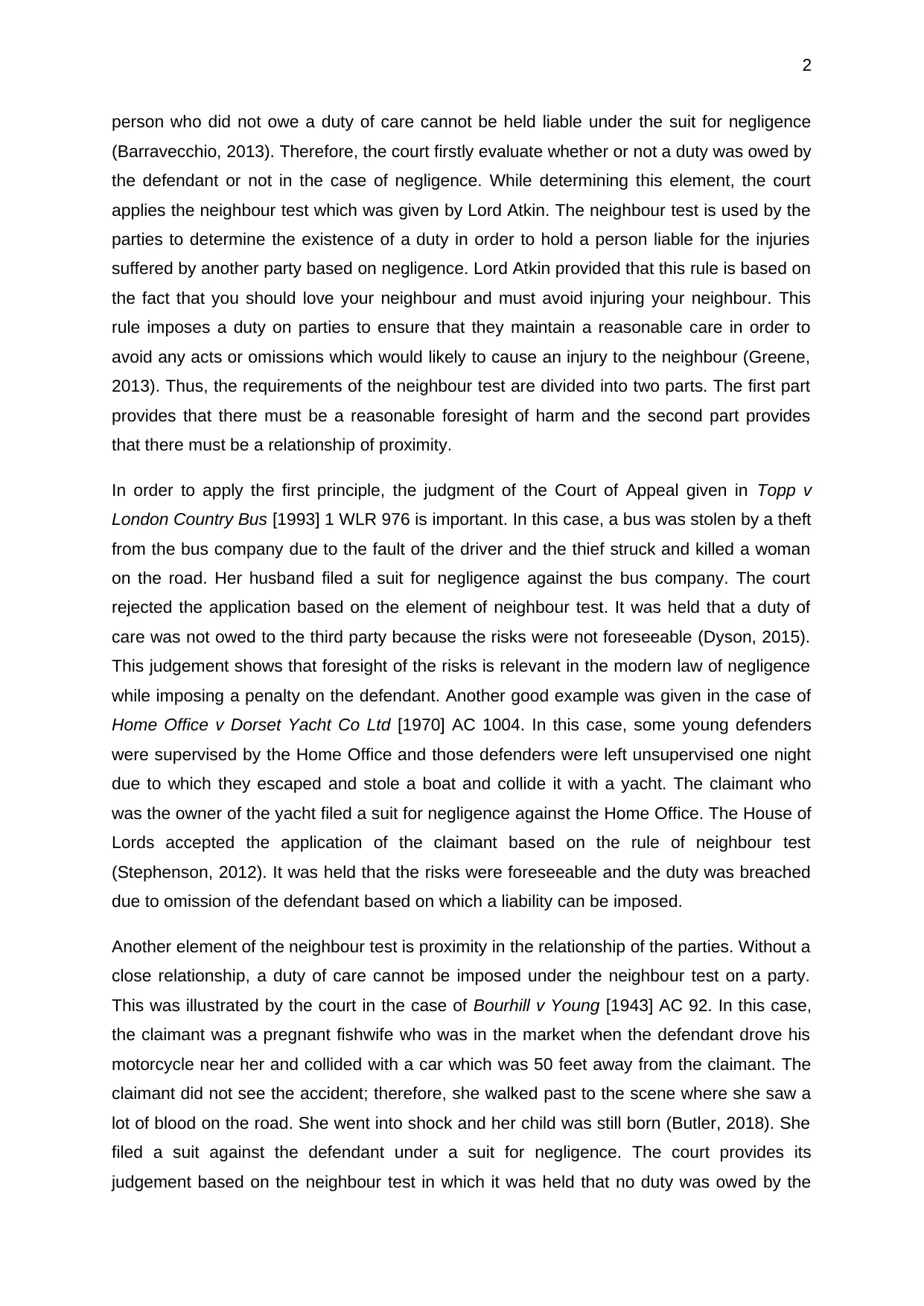
2
person who did not owe a duty of care cannot be held liable under the suit for negligence
(Barravecchio, 2013). Therefore, the court firstly evaluate whether or not a duty was owed by
the defendant or not in the case of negligence. While determining this element, the court
applies the neighbour test which was given by Lord Atkin. The neighbour test is used by the
parties to determine the existence of a duty in order to hold a person liable for the injuries
suffered by another party based on negligence. Lord Atkin provided that this rule is based on
the fact that you should love your neighbour and must avoid injuring your neighbour. This
rule imposes a duty on parties to ensure that they maintain a reasonable care in order to
avoid any acts or omissions which would likely to cause an injury to the neighbour (Greene,
2013). Thus, the requirements of the neighbour test are divided into two parts. The first part
provides that there must be a reasonable foresight of harm and the second part provides
that there must be a relationship of proximity.
In order to apply the first principle, the judgment of the Court of Appeal given in Topp v
London Country Bus [1993] 1 WLR 976 is important. In this case, a bus was stolen by a theft
from the bus company due to the fault of the driver and the thief struck and killed a woman
on the road. Her husband filed a suit for negligence against the bus company. The court
rejected the application based on the element of neighbour test. It was held that a duty of
care was not owed to the third party because the risks were not foreseeable (Dyson, 2015).
This judgement shows that foresight of the risks is relevant in the modern law of negligence
while imposing a penalty on the defendant. Another good example was given in the case of
Home Office v Dorset Yacht Co Ltd [1970] AC 1004. In this case, some young defenders
were supervised by the Home Office and those defenders were left unsupervised one night
due to which they escaped and stole a boat and collide it with a yacht. The claimant who
was the owner of the yacht filed a suit for negligence against the Home Office. The House of
Lords accepted the application of the claimant based on the rule of neighbour test
(Stephenson, 2012). It was held that the risks were foreseeable and the duty was breached
due to omission of the defendant based on which a liability can be imposed.
Another element of the neighbour test is proximity in the relationship of the parties. Without a
close relationship, a duty of care cannot be imposed under the neighbour test on a party.
This was illustrated by the court in the case of Bourhill v Young [1943] AC 92. In this case,
the claimant was a pregnant fishwife who was in the market when the defendant drove his
motorcycle near her and collided with a car which was 50 feet away from the claimant. The
claimant did not see the accident; therefore, she walked past to the scene where she saw a
lot of blood on the road. She went into shock and her child was still born (Butler, 2018). She
filed a suit against the defendant under a suit for negligence. The court provides its
judgement based on the neighbour test in which it was held that no duty was owed by the
person who did not owe a duty of care cannot be held liable under the suit for negligence
(Barravecchio, 2013). Therefore, the court firstly evaluate whether or not a duty was owed by
the defendant or not in the case of negligence. While determining this element, the court
applies the neighbour test which was given by Lord Atkin. The neighbour test is used by the
parties to determine the existence of a duty in order to hold a person liable for the injuries
suffered by another party based on negligence. Lord Atkin provided that this rule is based on
the fact that you should love your neighbour and must avoid injuring your neighbour. This
rule imposes a duty on parties to ensure that they maintain a reasonable care in order to
avoid any acts or omissions which would likely to cause an injury to the neighbour (Greene,
2013). Thus, the requirements of the neighbour test are divided into two parts. The first part
provides that there must be a reasonable foresight of harm and the second part provides
that there must be a relationship of proximity.
In order to apply the first principle, the judgment of the Court of Appeal given in Topp v
London Country Bus [1993] 1 WLR 976 is important. In this case, a bus was stolen by a theft
from the bus company due to the fault of the driver and the thief struck and killed a woman
on the road. Her husband filed a suit for negligence against the bus company. The court
rejected the application based on the element of neighbour test. It was held that a duty of
care was not owed to the third party because the risks were not foreseeable (Dyson, 2015).
This judgement shows that foresight of the risks is relevant in the modern law of negligence
while imposing a penalty on the defendant. Another good example was given in the case of
Home Office v Dorset Yacht Co Ltd [1970] AC 1004. In this case, some young defenders
were supervised by the Home Office and those defenders were left unsupervised one night
due to which they escaped and stole a boat and collide it with a yacht. The claimant who
was the owner of the yacht filed a suit for negligence against the Home Office. The House of
Lords accepted the application of the claimant based on the rule of neighbour test
(Stephenson, 2012). It was held that the risks were foreseeable and the duty was breached
due to omission of the defendant based on which a liability can be imposed.
Another element of the neighbour test is proximity in the relationship of the parties. Without a
close relationship, a duty of care cannot be imposed under the neighbour test on a party.
This was illustrated by the court in the case of Bourhill v Young [1943] AC 92. In this case,
the claimant was a pregnant fishwife who was in the market when the defendant drove his
motorcycle near her and collided with a car which was 50 feet away from the claimant. The
claimant did not see the accident; therefore, she walked past to the scene where she saw a
lot of blood on the road. She went into shock and her child was still born (Butler, 2018). She
filed a suit against the defendant under a suit for negligence. The court provides its
judgement based on the neighbour test in which it was held that no duty was owed by the
⊘ This is a preview!⊘
Do you want full access?
Subscribe today to unlock all pages.

Trusted by 1+ million students worldwide
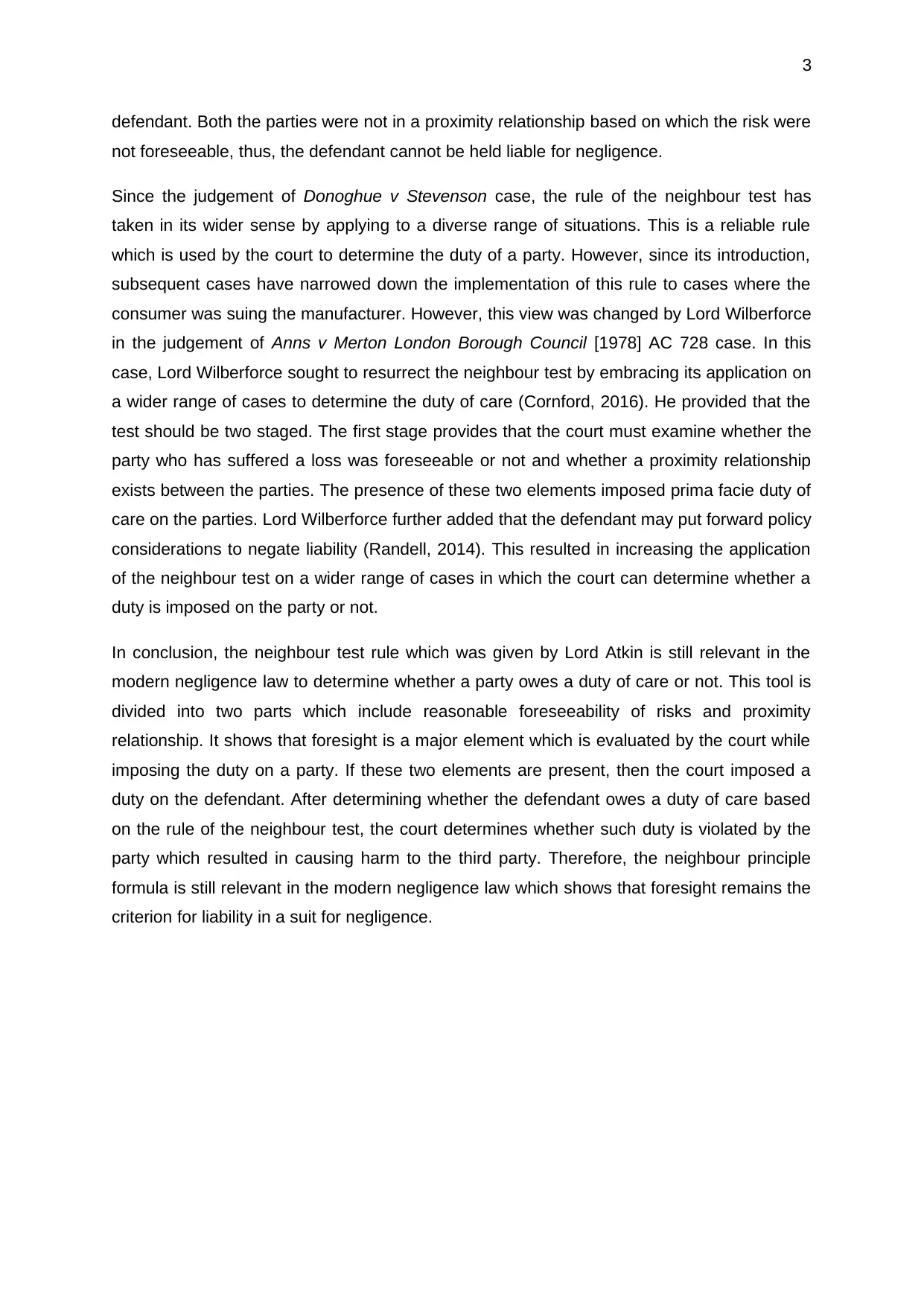
3
defendant. Both the parties were not in a proximity relationship based on which the risk were
not foreseeable, thus, the defendant cannot be held liable for negligence.
Since the judgement of Donoghue v Stevenson case, the rule of the neighbour test has
taken in its wider sense by applying to a diverse range of situations. This is a reliable rule
which is used by the court to determine the duty of a party. However, since its introduction,
subsequent cases have narrowed down the implementation of this rule to cases where the
consumer was suing the manufacturer. However, this view was changed by Lord Wilberforce
in the judgement of Anns v Merton London Borough Council [1978] AC 728 case. In this
case, Lord Wilberforce sought to resurrect the neighbour test by embracing its application on
a wider range of cases to determine the duty of care (Cornford, 2016). He provided that the
test should be two staged. The first stage provides that the court must examine whether the
party who has suffered a loss was foreseeable or not and whether a proximity relationship
exists between the parties. The presence of these two elements imposed prima facie duty of
care on the parties. Lord Wilberforce further added that the defendant may put forward policy
considerations to negate liability (Randell, 2014). This resulted in increasing the application
of the neighbour test on a wider range of cases in which the court can determine whether a
duty is imposed on the party or not.
In conclusion, the neighbour test rule which was given by Lord Atkin is still relevant in the
modern negligence law to determine whether a party owes a duty of care or not. This tool is
divided into two parts which include reasonable foreseeability of risks and proximity
relationship. It shows that foresight is a major element which is evaluated by the court while
imposing the duty on a party. If these two elements are present, then the court imposed a
duty on the defendant. After determining whether the defendant owes a duty of care based
on the rule of the neighbour test, the court determines whether such duty is violated by the
party which resulted in causing harm to the third party. Therefore, the neighbour principle
formula is still relevant in the modern negligence law which shows that foresight remains the
criterion for liability in a suit for negligence.
defendant. Both the parties were not in a proximity relationship based on which the risk were
not foreseeable, thus, the defendant cannot be held liable for negligence.
Since the judgement of Donoghue v Stevenson case, the rule of the neighbour test has
taken in its wider sense by applying to a diverse range of situations. This is a reliable rule
which is used by the court to determine the duty of a party. However, since its introduction,
subsequent cases have narrowed down the implementation of this rule to cases where the
consumer was suing the manufacturer. However, this view was changed by Lord Wilberforce
in the judgement of Anns v Merton London Borough Council [1978] AC 728 case. In this
case, Lord Wilberforce sought to resurrect the neighbour test by embracing its application on
a wider range of cases to determine the duty of care (Cornford, 2016). He provided that the
test should be two staged. The first stage provides that the court must examine whether the
party who has suffered a loss was foreseeable or not and whether a proximity relationship
exists between the parties. The presence of these two elements imposed prima facie duty of
care on the parties. Lord Wilberforce further added that the defendant may put forward policy
considerations to negate liability (Randell, 2014). This resulted in increasing the application
of the neighbour test on a wider range of cases in which the court can determine whether a
duty is imposed on the party or not.
In conclusion, the neighbour test rule which was given by Lord Atkin is still relevant in the
modern negligence law to determine whether a party owes a duty of care or not. This tool is
divided into two parts which include reasonable foreseeability of risks and proximity
relationship. It shows that foresight is a major element which is evaluated by the court while
imposing the duty on a party. If these two elements are present, then the court imposed a
duty on the defendant. After determining whether the defendant owes a duty of care based
on the rule of the neighbour test, the court determines whether such duty is violated by the
party which resulted in causing harm to the third party. Therefore, the neighbour principle
formula is still relevant in the modern negligence law which shows that foresight remains the
criterion for liability in a suit for negligence.
Paraphrase This Document
Need a fresh take? Get an instant paraphrase of this document with our AI Paraphraser
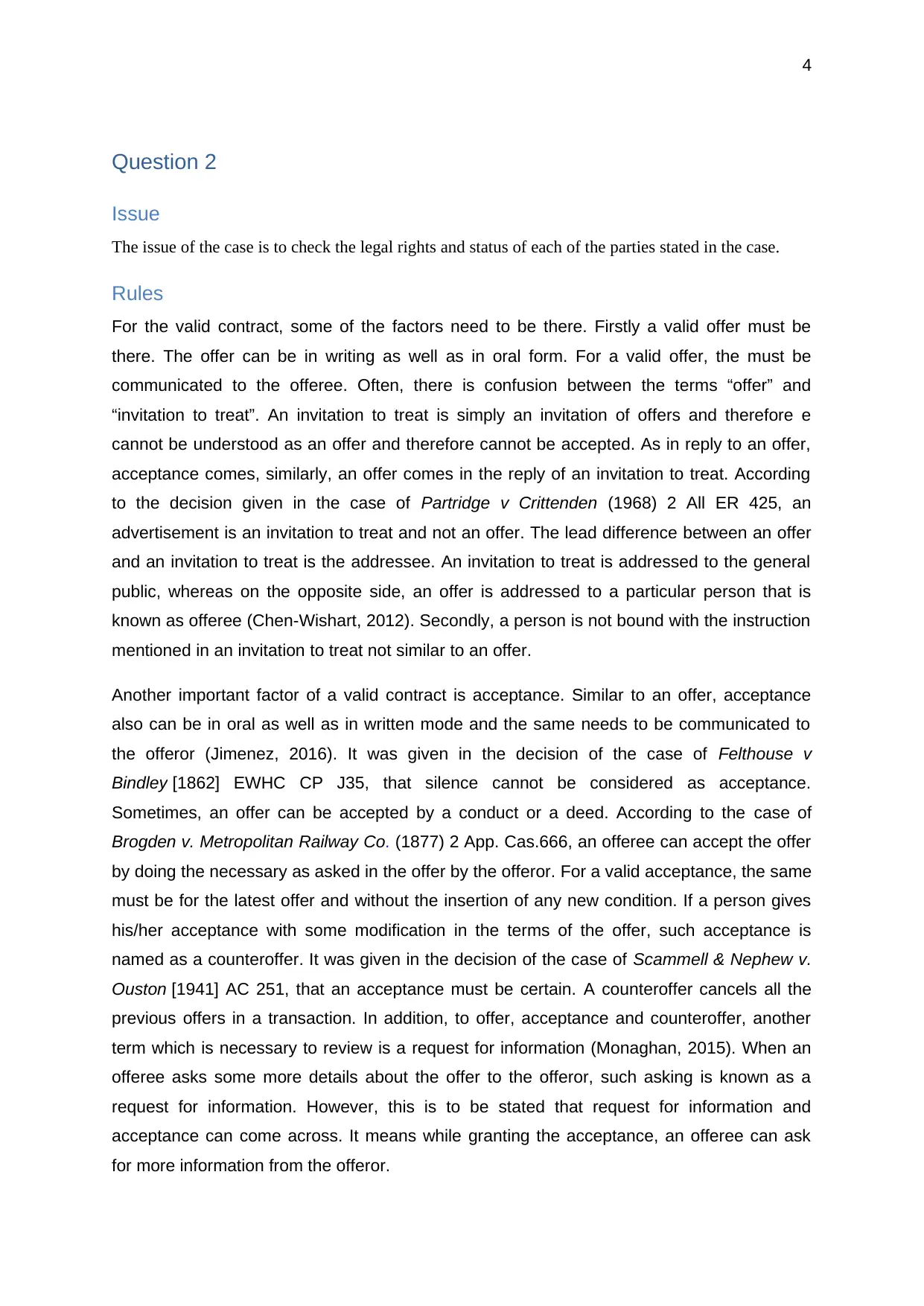
4
Question 2
Issue
The issue of the case is to check the legal rights and status of each of the parties stated in the case.
Rules
For the valid contract, some of the factors need to be there. Firstly a valid offer must be
there. The offer can be in writing as well as in oral form. For a valid offer, the must be
communicated to the offeree. Often, there is confusion between the terms “offer” and
“invitation to treat”. An invitation to treat is simply an invitation of offers and therefore e
cannot be understood as an offer and therefore cannot be accepted. As in reply to an offer,
acceptance comes, similarly, an offer comes in the reply of an invitation to treat. According
to the decision given in the case of Partridge v Crittenden (1968) 2 All ER 425, an
advertisement is an invitation to treat and not an offer. The lead difference between an offer
and an invitation to treat is the addressee. An invitation to treat is addressed to the general
public, whereas on the opposite side, an offer is addressed to a particular person that is
known as offeree (Chen-Wishart, 2012). Secondly, a person is not bound with the instruction
mentioned in an invitation to treat not similar to an offer.
Another important factor of a valid contract is acceptance. Similar to an offer, acceptance
also can be in oral as well as in written mode and the same needs to be communicated to
the offeror (Jimenez, 2016). It was given in the decision of the case of Felthouse v
Bindley [1862] EWHC CP J35, that silence cannot be considered as acceptance.
Sometimes, an offer can be accepted by a conduct or a deed. According to the case of
Brogden v. Metropolitan Railway Co. (1877) 2 App. Cas.666, an offeree can accept the offer
by doing the necessary as asked in the offer by the offeror. For a valid acceptance, the same
must be for the latest offer and without the insertion of any new condition. If a person gives
his/her acceptance with some modification in the terms of the offer, such acceptance is
named as a counteroffer. It was given in the decision of the case of Scammell & Nephew v.
Ouston [1941] AC 251, that an acceptance must be certain. A counteroffer cancels all the
previous offers in a transaction. In addition, to offer, acceptance and counteroffer, another
term which is necessary to review is a request for information (Monaghan, 2015). When an
offeree asks some more details about the offer to the offeror, such asking is known as a
request for information. However, this is to be stated that request for information and
acceptance can come across. It means while granting the acceptance, an offeree can ask
for more information from the offeror.
Question 2
Issue
The issue of the case is to check the legal rights and status of each of the parties stated in the case.
Rules
For the valid contract, some of the factors need to be there. Firstly a valid offer must be
there. The offer can be in writing as well as in oral form. For a valid offer, the must be
communicated to the offeree. Often, there is confusion between the terms “offer” and
“invitation to treat”. An invitation to treat is simply an invitation of offers and therefore e
cannot be understood as an offer and therefore cannot be accepted. As in reply to an offer,
acceptance comes, similarly, an offer comes in the reply of an invitation to treat. According
to the decision given in the case of Partridge v Crittenden (1968) 2 All ER 425, an
advertisement is an invitation to treat and not an offer. The lead difference between an offer
and an invitation to treat is the addressee. An invitation to treat is addressed to the general
public, whereas on the opposite side, an offer is addressed to a particular person that is
known as offeree (Chen-Wishart, 2012). Secondly, a person is not bound with the instruction
mentioned in an invitation to treat not similar to an offer.
Another important factor of a valid contract is acceptance. Similar to an offer, acceptance
also can be in oral as well as in written mode and the same needs to be communicated to
the offeror (Jimenez, 2016). It was given in the decision of the case of Felthouse v
Bindley [1862] EWHC CP J35, that silence cannot be considered as acceptance.
Sometimes, an offer can be accepted by a conduct or a deed. According to the case of
Brogden v. Metropolitan Railway Co. (1877) 2 App. Cas.666, an offeree can accept the offer
by doing the necessary as asked in the offer by the offeror. For a valid acceptance, the same
must be for the latest offer and without the insertion of any new condition. If a person gives
his/her acceptance with some modification in the terms of the offer, such acceptance is
named as a counteroffer. It was given in the decision of the case of Scammell & Nephew v.
Ouston [1941] AC 251, that an acceptance must be certain. A counteroffer cancels all the
previous offers in a transaction. In addition, to offer, acceptance and counteroffer, another
term which is necessary to review is a request for information (Monaghan, 2015). When an
offeree asks some more details about the offer to the offeror, such asking is known as a
request for information. However, this is to be stated that request for information and
acceptance can come across. It means while granting the acceptance, an offeree can ask
for more information from the offeror.
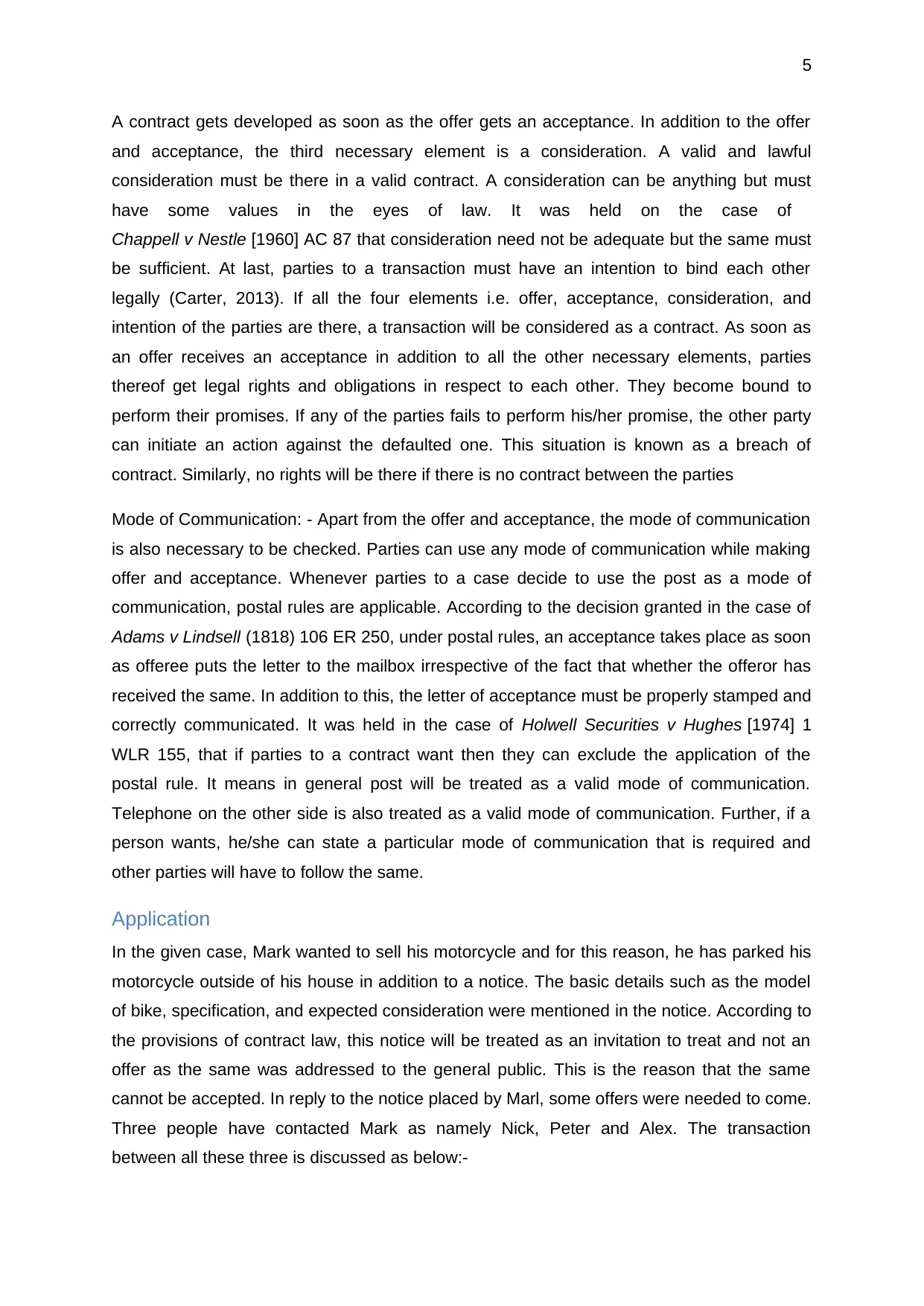
5
A contract gets developed as soon as the offer gets an acceptance. In addition to the offer
and acceptance, the third necessary element is a consideration. A valid and lawful
consideration must be there in a valid contract. A consideration can be anything but must
have some values in the eyes of law. It was held on the case of
Chappell v Nestle [1960] AC 87 that consideration need not be adequate but the same must
be sufficient. At last, parties to a transaction must have an intention to bind each other
legally (Carter, 2013). If all the four elements i.e. offer, acceptance, consideration, and
intention of the parties are there, a transaction will be considered as a contract. As soon as
an offer receives an acceptance in addition to all the other necessary elements, parties
thereof get legal rights and obligations in respect to each other. They become bound to
perform their promises. If any of the parties fails to perform his/her promise, the other party
can initiate an action against the defaulted one. This situation is known as a breach of
contract. Similarly, no rights will be there if there is no contract between the parties
Mode of Communication: - Apart from the offer and acceptance, the mode of communication
is also necessary to be checked. Parties can use any mode of communication while making
offer and acceptance. Whenever parties to a case decide to use the post as a mode of
communication, postal rules are applicable. According to the decision granted in the case of
Adams v Lindsell (1818) 106 ER 250, under postal rules, an acceptance takes place as soon
as offeree puts the letter to the mailbox irrespective of the fact that whether the offeror has
received the same. In addition to this, the letter of acceptance must be properly stamped and
correctly communicated. It was held in the case of Holwell Securities v Hughes [1974] 1
WLR 155, that if parties to a contract want then they can exclude the application of the
postal rule. It means in general post will be treated as a valid mode of communication.
Telephone on the other side is also treated as a valid mode of communication. Further, if a
person wants, he/she can state a particular mode of communication that is required and
other parties will have to follow the same.
Application
In the given case, Mark wanted to sell his motorcycle and for this reason, he has parked his
motorcycle outside of his house in addition to a notice. The basic details such as the model
of bike, specification, and expected consideration were mentioned in the notice. According to
the provisions of contract law, this notice will be treated as an invitation to treat and not an
offer as the same was addressed to the general public. This is the reason that the same
cannot be accepted. In reply to the notice placed by Marl, some offers were needed to come.
Three people have contacted Mark as namely Nick, Peter and Alex. The transaction
between all these three is discussed as below:-
A contract gets developed as soon as the offer gets an acceptance. In addition to the offer
and acceptance, the third necessary element is a consideration. A valid and lawful
consideration must be there in a valid contract. A consideration can be anything but must
have some values in the eyes of law. It was held on the case of
Chappell v Nestle [1960] AC 87 that consideration need not be adequate but the same must
be sufficient. At last, parties to a transaction must have an intention to bind each other
legally (Carter, 2013). If all the four elements i.e. offer, acceptance, consideration, and
intention of the parties are there, a transaction will be considered as a contract. As soon as
an offer receives an acceptance in addition to all the other necessary elements, parties
thereof get legal rights and obligations in respect to each other. They become bound to
perform their promises. If any of the parties fails to perform his/her promise, the other party
can initiate an action against the defaulted one. This situation is known as a breach of
contract. Similarly, no rights will be there if there is no contract between the parties
Mode of Communication: - Apart from the offer and acceptance, the mode of communication
is also necessary to be checked. Parties can use any mode of communication while making
offer and acceptance. Whenever parties to a case decide to use the post as a mode of
communication, postal rules are applicable. According to the decision granted in the case of
Adams v Lindsell (1818) 106 ER 250, under postal rules, an acceptance takes place as soon
as offeree puts the letter to the mailbox irrespective of the fact that whether the offeror has
received the same. In addition to this, the letter of acceptance must be properly stamped and
correctly communicated. It was held in the case of Holwell Securities v Hughes [1974] 1
WLR 155, that if parties to a contract want then they can exclude the application of the
postal rule. It means in general post will be treated as a valid mode of communication.
Telephone on the other side is also treated as a valid mode of communication. Further, if a
person wants, he/she can state a particular mode of communication that is required and
other parties will have to follow the same.
Application
In the given case, Mark wanted to sell his motorcycle and for this reason, he has parked his
motorcycle outside of his house in addition to a notice. The basic details such as the model
of bike, specification, and expected consideration were mentioned in the notice. According to
the provisions of contract law, this notice will be treated as an invitation to treat and not an
offer as the same was addressed to the general public. This is the reason that the same
cannot be accepted. In reply to the notice placed by Marl, some offers were needed to come.
Three people have contacted Mark as namely Nick, Peter and Alex. The transaction
between all these three is discussed as below:-
⊘ This is a preview!⊘
Do you want full access?
Subscribe today to unlock all pages.

Trusted by 1+ million students worldwide
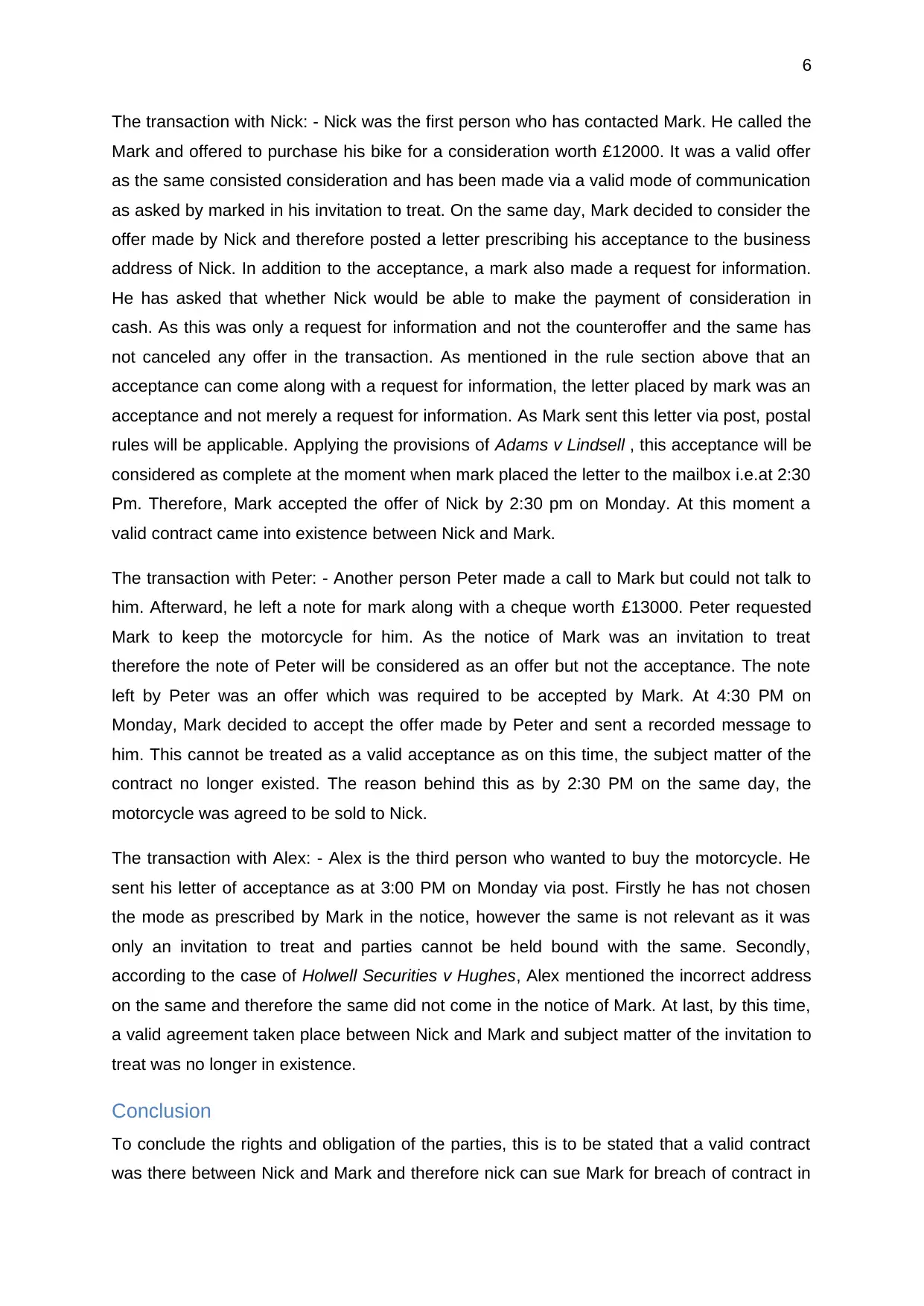
6
The transaction with Nick: - Nick was the first person who has contacted Mark. He called the
Mark and offered to purchase his bike for a consideration worth £12000. It was a valid offer
as the same consisted consideration and has been made via a valid mode of communication
as asked by marked in his invitation to treat. On the same day, Mark decided to consider the
offer made by Nick and therefore posted a letter prescribing his acceptance to the business
address of Nick. In addition to the acceptance, a mark also made a request for information.
He has asked that whether Nick would be able to make the payment of consideration in
cash. As this was only a request for information and not the counteroffer and the same has
not canceled any offer in the transaction. As mentioned in the rule section above that an
acceptance can come along with a request for information, the letter placed by mark was an
acceptance and not merely a request for information. As Mark sent this letter via post, postal
rules will be applicable. Applying the provisions of Adams v Lindsell , this acceptance will be
considered as complete at the moment when mark placed the letter to the mailbox i.e.at 2:30
Pm. Therefore, Mark accepted the offer of Nick by 2:30 pm on Monday. At this moment a
valid contract came into existence between Nick and Mark.
The transaction with Peter: - Another person Peter made a call to Mark but could not talk to
him. Afterward, he left a note for mark along with a cheque worth £13000. Peter requested
Mark to keep the motorcycle for him. As the notice of Mark was an invitation to treat
therefore the note of Peter will be considered as an offer but not the acceptance. The note
left by Peter was an offer which was required to be accepted by Mark. At 4:30 PM on
Monday, Mark decided to accept the offer made by Peter and sent a recorded message to
him. This cannot be treated as a valid acceptance as on this time, the subject matter of the
contract no longer existed. The reason behind this as by 2:30 PM on the same day, the
motorcycle was agreed to be sold to Nick.
The transaction with Alex: - Alex is the third person who wanted to buy the motorcycle. He
sent his letter of acceptance as at 3:00 PM on Monday via post. Firstly he has not chosen
the mode as prescribed by Mark in the notice, however the same is not relevant as it was
only an invitation to treat and parties cannot be held bound with the same. Secondly,
according to the case of Holwell Securities v Hughes, Alex mentioned the incorrect address
on the same and therefore the same did not come in the notice of Mark. At last, by this time,
a valid agreement taken place between Nick and Mark and subject matter of the invitation to
treat was no longer in existence.
Conclusion
To conclude the rights and obligation of the parties, this is to be stated that a valid contract
was there between Nick and Mark and therefore nick can sue Mark for breach of contract in
The transaction with Nick: - Nick was the first person who has contacted Mark. He called the
Mark and offered to purchase his bike for a consideration worth £12000. It was a valid offer
as the same consisted consideration and has been made via a valid mode of communication
as asked by marked in his invitation to treat. On the same day, Mark decided to consider the
offer made by Nick and therefore posted a letter prescribing his acceptance to the business
address of Nick. In addition to the acceptance, a mark also made a request for information.
He has asked that whether Nick would be able to make the payment of consideration in
cash. As this was only a request for information and not the counteroffer and the same has
not canceled any offer in the transaction. As mentioned in the rule section above that an
acceptance can come along with a request for information, the letter placed by mark was an
acceptance and not merely a request for information. As Mark sent this letter via post, postal
rules will be applicable. Applying the provisions of Adams v Lindsell , this acceptance will be
considered as complete at the moment when mark placed the letter to the mailbox i.e.at 2:30
Pm. Therefore, Mark accepted the offer of Nick by 2:30 pm on Monday. At this moment a
valid contract came into existence between Nick and Mark.
The transaction with Peter: - Another person Peter made a call to Mark but could not talk to
him. Afterward, he left a note for mark along with a cheque worth £13000. Peter requested
Mark to keep the motorcycle for him. As the notice of Mark was an invitation to treat
therefore the note of Peter will be considered as an offer but not the acceptance. The note
left by Peter was an offer which was required to be accepted by Mark. At 4:30 PM on
Monday, Mark decided to accept the offer made by Peter and sent a recorded message to
him. This cannot be treated as a valid acceptance as on this time, the subject matter of the
contract no longer existed. The reason behind this as by 2:30 PM on the same day, the
motorcycle was agreed to be sold to Nick.
The transaction with Alex: - Alex is the third person who wanted to buy the motorcycle. He
sent his letter of acceptance as at 3:00 PM on Monday via post. Firstly he has not chosen
the mode as prescribed by Mark in the notice, however the same is not relevant as it was
only an invitation to treat and parties cannot be held bound with the same. Secondly,
according to the case of Holwell Securities v Hughes, Alex mentioned the incorrect address
on the same and therefore the same did not come in the notice of Mark. At last, by this time,
a valid agreement taken place between Nick and Mark and subject matter of the invitation to
treat was no longer in existence.
Conclusion
To conclude the rights and obligation of the parties, this is to be stated that a valid contract
was there between Nick and Mark and therefore nick can sue Mark for breach of contract in
Paraphrase This Document
Need a fresh take? Get an instant paraphrase of this document with our AI Paraphraser

7
case of failure of performance. Further, Peter and Alex have no right in relation to mark as
no contract was there with Mark. Mark cannot accept the offer of Peter as he already
accepted the offer made by Nick and now is liable to sell his motorcycle to Nick only.
case of failure of performance. Further, Peter and Alex have no right in relation to mark as
no contract was there with Mark. Mark cannot accept the offer of Peter as he already
accepted the offer made by Nick and now is liable to sell his motorcycle to Nick only.
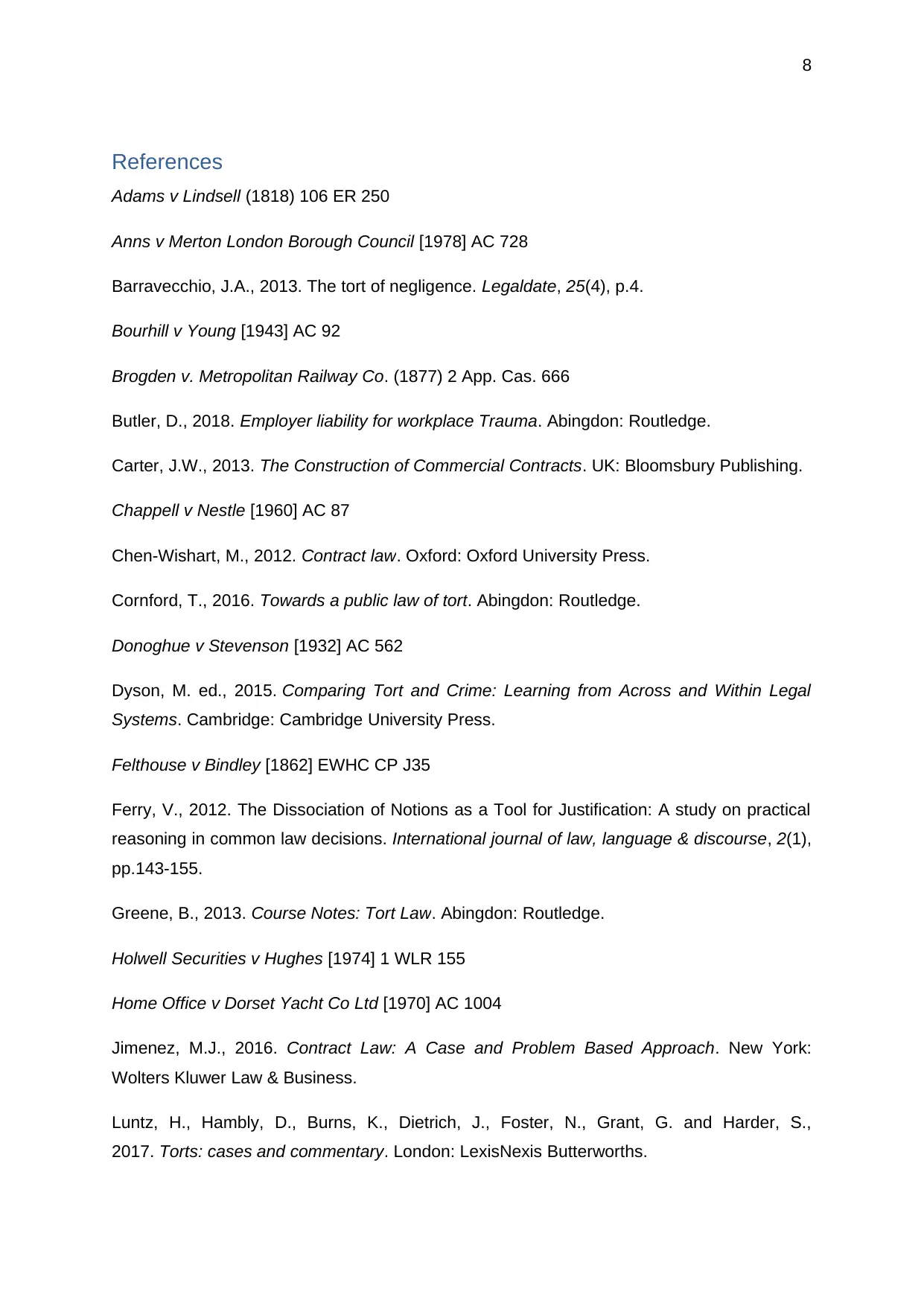
8
References
Adams v Lindsell (1818) 106 ER 250
Anns v Merton London Borough Council [1978] AC 728
Barravecchio, J.A., 2013. The tort of negligence. Legaldate, 25(4), p.4.
Bourhill v Young [1943] AC 92
Brogden v. Metropolitan Railway Co. (1877) 2 App. Cas. 666
Butler, D., 2018. Employer liability for workplace Trauma. Abingdon: Routledge.
Carter, J.W., 2013. The Construction of Commercial Contracts. UK: Bloomsbury Publishing.
Chappell v Nestle [1960] AC 87
Chen-Wishart, M., 2012. Contract law. Oxford: Oxford University Press.
Cornford, T., 2016. Towards a public law of tort. Abingdon: Routledge.
Donoghue v Stevenson [1932] AC 562
Dyson, M. ed., 2015. Comparing Tort and Crime: Learning from Across and Within Legal
Systems. Cambridge: Cambridge University Press.
Felthouse v Bindley [1862] EWHC CP J35
Ferry, V., 2012. The Dissociation of Notions as a Tool for Justification: A study on practical
reasoning in common law decisions. International journal of law, language & discourse, 2(1),
pp.143-155.
Greene, B., 2013. Course Notes: Tort Law. Abingdon: Routledge.
Holwell Securities v Hughes [1974] 1 WLR 155
Home Office v Dorset Yacht Co Ltd [1970] AC 1004
Jimenez, M.J., 2016. Contract Law: A Case and Problem Based Approach. New York:
Wolters Kluwer Law & Business.
Luntz, H., Hambly, D., Burns, K., Dietrich, J., Foster, N., Grant, G. and Harder, S.,
2017. Torts: cases and commentary. London: LexisNexis Butterworths.
References
Adams v Lindsell (1818) 106 ER 250
Anns v Merton London Borough Council [1978] AC 728
Barravecchio, J.A., 2013. The tort of negligence. Legaldate, 25(4), p.4.
Bourhill v Young [1943] AC 92
Brogden v. Metropolitan Railway Co. (1877) 2 App. Cas. 666
Butler, D., 2018. Employer liability for workplace Trauma. Abingdon: Routledge.
Carter, J.W., 2013. The Construction of Commercial Contracts. UK: Bloomsbury Publishing.
Chappell v Nestle [1960] AC 87
Chen-Wishart, M., 2012. Contract law. Oxford: Oxford University Press.
Cornford, T., 2016. Towards a public law of tort. Abingdon: Routledge.
Donoghue v Stevenson [1932] AC 562
Dyson, M. ed., 2015. Comparing Tort and Crime: Learning from Across and Within Legal
Systems. Cambridge: Cambridge University Press.
Felthouse v Bindley [1862] EWHC CP J35
Ferry, V., 2012. The Dissociation of Notions as a Tool for Justification: A study on practical
reasoning in common law decisions. International journal of law, language & discourse, 2(1),
pp.143-155.
Greene, B., 2013. Course Notes: Tort Law. Abingdon: Routledge.
Holwell Securities v Hughes [1974] 1 WLR 155
Home Office v Dorset Yacht Co Ltd [1970] AC 1004
Jimenez, M.J., 2016. Contract Law: A Case and Problem Based Approach. New York:
Wolters Kluwer Law & Business.
Luntz, H., Hambly, D., Burns, K., Dietrich, J., Foster, N., Grant, G. and Harder, S.,
2017. Torts: cases and commentary. London: LexisNexis Butterworths.
⊘ This is a preview!⊘
Do you want full access?
Subscribe today to unlock all pages.

Trusted by 1+ million students worldwide
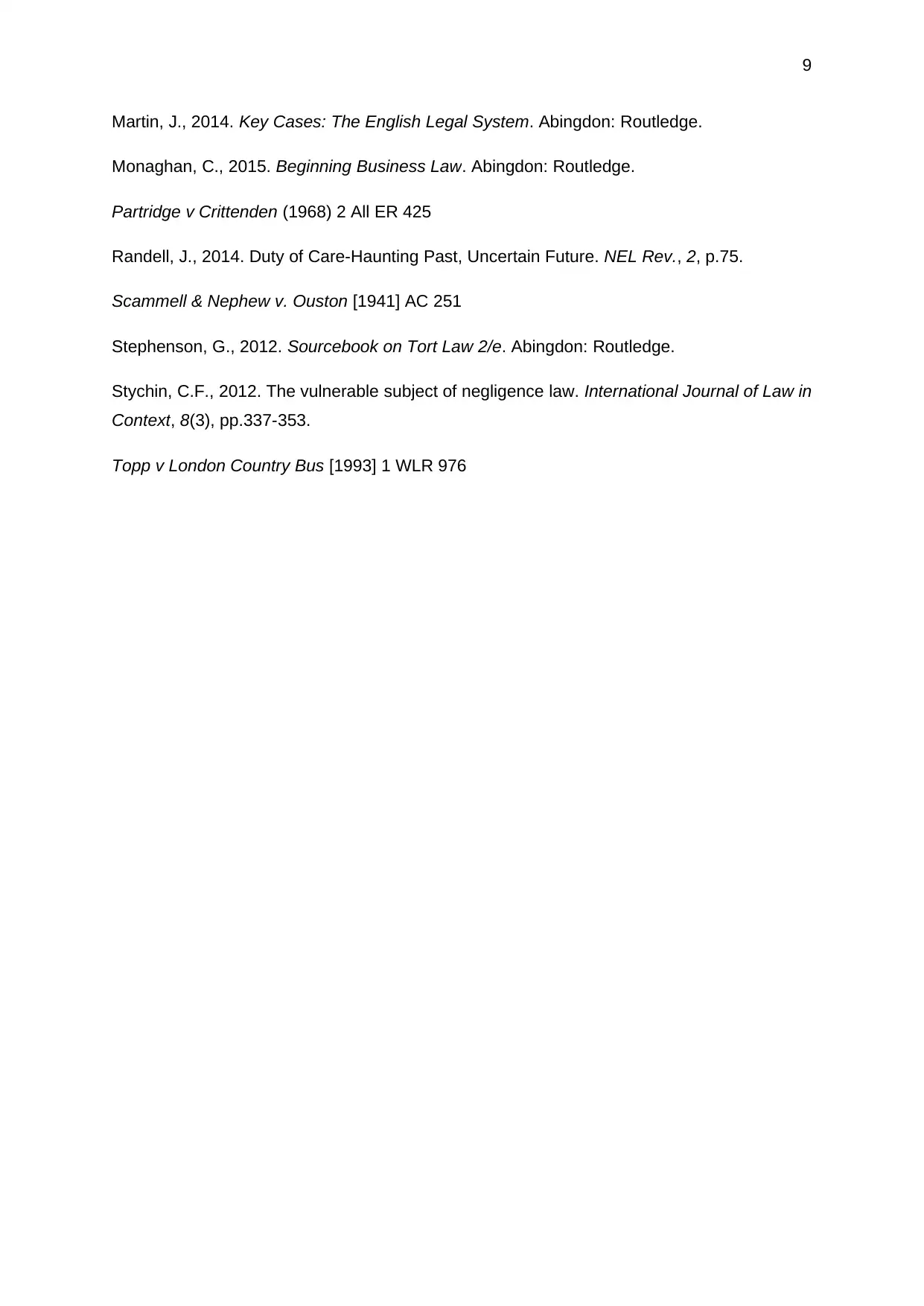
9
Martin, J., 2014. Key Cases: The English Legal System. Abingdon: Routledge.
Monaghan, C., 2015. Beginning Business Law. Abingdon: Routledge.
Partridge v Crittenden (1968) 2 All ER 425
Randell, J., 2014. Duty of Care-Haunting Past, Uncertain Future. NEL Rev., 2, p.75.
Scammell & Nephew v. Ouston [1941] AC 251
Stephenson, G., 2012. Sourcebook on Tort Law 2/e. Abingdon: Routledge.
Stychin, C.F., 2012. The vulnerable subject of negligence law. International Journal of Law in
Context, 8(3), pp.337-353.
Topp v London Country Bus [1993] 1 WLR 976
Martin, J., 2014. Key Cases: The English Legal System. Abingdon: Routledge.
Monaghan, C., 2015. Beginning Business Law. Abingdon: Routledge.
Partridge v Crittenden (1968) 2 All ER 425
Randell, J., 2014. Duty of Care-Haunting Past, Uncertain Future. NEL Rev., 2, p.75.
Scammell & Nephew v. Ouston [1941] AC 251
Stephenson, G., 2012. Sourcebook on Tort Law 2/e. Abingdon: Routledge.
Stychin, C.F., 2012. The vulnerable subject of negligence law. International Journal of Law in
Context, 8(3), pp.337-353.
Topp v London Country Bus [1993] 1 WLR 976
1 out of 10
Related Documents
Your All-in-One AI-Powered Toolkit for Academic Success.
+13062052269
info@desklib.com
Available 24*7 on WhatsApp / Email
![[object Object]](/_next/static/media/star-bottom.7253800d.svg)
Unlock your academic potential
Copyright © 2020–2025 A2Z Services. All Rights Reserved. Developed and managed by ZUCOL.




